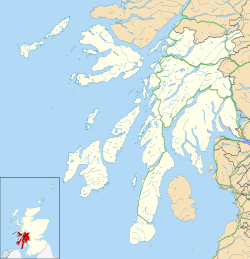Lismore Seminary
| Lismore Seminary | |
|---|---|
| Coordinates: 56°29′27″N 5°32′07″W / 56.4908°N 5.5354°W | |
| Location | Lismore, Argyll |
| Country | Scotland |
| Denomination | Roman Catholic |
| History | |
| Former name(s) | Kilcheran House |
| Founded | 1801 |
| Founder(s) | Bishop John Chisholm |
| Architecture | |
| Status | Closed |
| Functional status | Private House |
| Heritage designation | Category B |
| Designated | 20 July 1971 |
| Closed | 1829 |
Lismore Seminary was situated in Kilcheran House on the island of Lismore in the Inner Hebrides part of Argyll, Scotland. It served as a seminary for the Roman Catholic Church in Scotland in the 19th century. At the time it was the only seminary in the west of Scotland and for the Vicariate Apostolic of the Highland District. The house still stands and has a lime kiln from the time of the seminary within the grounds. Both the house and the kiln are category B listed sites.
Before the seminary moved to Lismore, Scottish seminarians were trained at Samalaman House near Loch Ailort. The house was previously owned by Bishop Alexander MacDonald. The seminary was there from 1783 to 1803. The amount of students at the college were increasing but the site was quite a small place, cramped and uncomfortable, with leaking roofs and unsubstantial walls. So, from 1798, Bishop John Chisholm started to look for a larger and more suitable location.
In 1803, a property was found that cost £5,000 that had a large enough house and substantial gardens. Somehow the Vicariate was able to afford it. So, Bishop Chisholm founded the new seminary on the island of Lismore. The island was staunchly Presbyterian, and there must have been an unexpected feeling on the island when the inhabitants learned of a Catholic seminary being located in their vicinity.
Objections were also raised by Catholics in Scotland. Samalaman seminary was on the mainland and in an area occupied by Catholics, but the new seminary was on an island with no Catholic inhabitants. Bishop Chisholm dismissed these objections by saying that it was more 'accessible here to the world than where I have formerly been at Moidart,' and that 'we never had more or so much liberty to apply ourselves to learning and spiritual matters in any other place.'
In addition to founding the seminary, Bishop Chisholm also ordered the construction of a limestone kiln that was built so that the seminary could benefit from revenues made by a local quarry. The lime kiln made such a local impression that, 1814, when Sir Walter Scott visited the area, he wrote that:
...
Wikipedia

